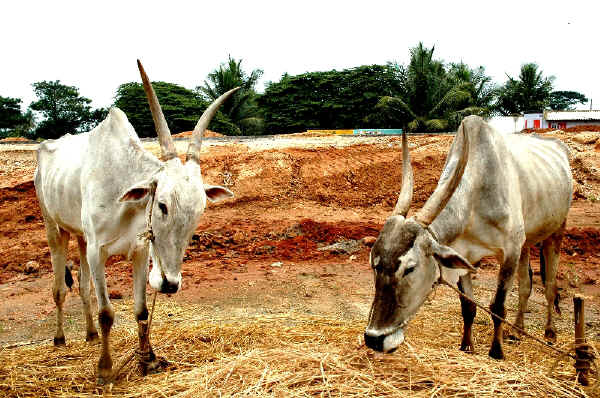Type the name of the breed you're looking for below
[wpdreams_ajaxsearchlite] Don't see the breed your're looking for? Click here and let us know!
Amrit Mahal cattle
| Place of Origin | India |
| Origin | State of Mysore in Karnataka, India. |
| Purpose | Draught (working) breed |
| Appearance | The coloring of Amrit Mahal cattle is usually some shade of gray varying from almost white to nearly black, and in some cases white-gray markings of a definite pattern are present on the face and dewlap. The muzzle, feet and tail switch are usually black, but in older animals the colour looks lighter. The most striking characteristic of these cattle is the formation of the head and horns. The head is well-shaped, long and tapering towards the muzzle. The forehead bulges out slightly and is narrow and furrowed in the middle. The eyes look bloodshot. The ears are small and taper to a point, being carried in a horizontal position. They are yellow inside. The dewlap is thin and does not extend very far. The sheath and navel flap are very small and close to the body. The hump is well-developed and shapely in the bulls, rising to a height of about 8 inches. The body is compact and muscular with well-formed shoulders and hindquarters. The neck is strong and fairly long. The back is level, with broad loins and level rump. Legs are of medium length and well-proportioned. The fetlocks are short and the hooves are hard, close together and small. The skin is thin, mellow and jet black in colour, with short glossy hair. |
| Horns | The horns emerge from the top of the poll, fairly close together in an upward and backward direction, and terminate in sharp points which are usually black. In old animals the long sharp points approximate each other and may even interlace to some extent. |
| Other Considerations | It is one of the two breeds, along with Hallikar, which have received the royal patronage and care from the erstwhile Vijayanagara Kingdom, sultans and princely state of Mysore through conservation and development. The present day existence of places with names kaval or Kaaval (Kannada:ಕಾವಲ್) in southern regions of Karnataka, which are the vast tracts of lands which were reserved to conserve and develop this breed of cattle in the Old Mysore region of Karnataka, stand as testimonies to the legacy of the Amrit Mahal breed. As the cattle are maintained in the pasture areas without any restrictions and handling, they show a very impatient, wild and unruly disposition. They are at time dangerous, particularly to strangers. They need patience and care in training; hard treatment makes them stubborn. Once they are trained they are extremely fine bullocks, particularly for quick transportation. They are observed to have great endurance. Cows are very poor milkers. |



